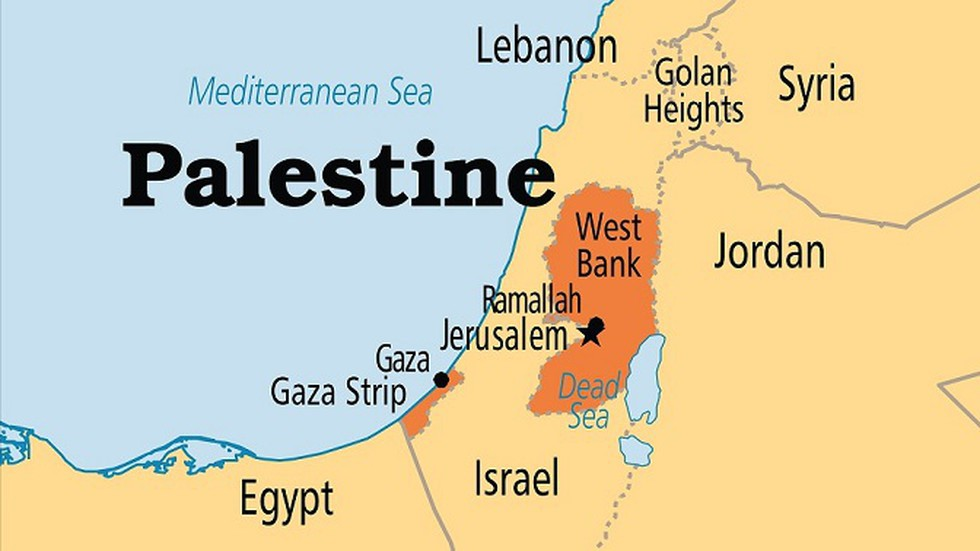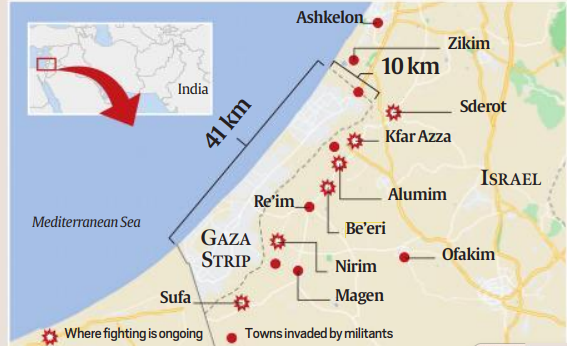Gaza Strip
Why in News?
The recent escalation of conflict between Israel and Hamas militants has thrust the Gaza Strip into the global spotlight.
- Amidst this turmoil, Israel's defense minister, declared a "complete siege" of the Gaza Strip, cutting off essential resources. This move has highlighted the long-standing and contentious issue of the Gaza blockade, which has been in place since 2007.
What are the Significant Aspects Regarding the Gaza Strip?
- About: The Gaza Strip is situated in the eastern Mediterranean basin, sharing borders with Egypt in the southwest and Israel to the north and east. To the west, it is bounded by the Mediterranean Sea.
- It is one of the most densely populated areas globally, with over 2 million residents living in a tiny area.
- The term "open air prison" has been widely used by academics, activists, and journalists to characterize the conditions in Gaza.
- Historical Significance:
- The Six-Day War of 1967 resulted in Israel capturing Gaza from Egypt and initiating its military occupation of the region.
- Israel withdrew its settlements from Gaza in 2005, but this period also saw intermittent blockades on the movement of people and goods.
- In 2007, after Hamas assumed power in Gaza, Israel and Egypt enforced a permanent blockade, justifying it as necessary for security.
- The United Nations Office for the Coordination of Humanitarian Affairs (OCHA) reported that the blockade has severely impacted Gaza's economy, resulting in high unemployment, food insecurity, and aid dependency.
- The Six-Day War of 1967 resulted in Israel capturing Gaza from Egypt and initiating its military occupation of the region.
- Related Border Areas:
- Gaza is encircled by walls on three sides, and its western border is controlled by Israel, restricting access by sea.
- Three functional border crossings exist - Karem Abu Salem Crossing and Erez Crossing controlled by Israel, and Rafah Crossing controlled by Egypt.
- These crossings have been sealed in response to recent hostilities.
- Gaza is encircled by walls on three sides, and its western border is controlled by Israel, restricting access by sea.
- Associated Places in Spotlight:
UPSC Civil Services Examination, Previous Year Question (PYQ)
Prelims
Q1. Yom Kippur War was fought between which sides/ countries? (2008)
(a) Turkey and Greece
(b) Serbs and Croats
(c) Israel, and Arab countries led by Egypt and Syria
(d) Iran and Iraq
Ans: (c)
Q2. Mediterranean Sea is a border of which of the following countries? (2017)
- Jordan
- Iraq
- Lebanon
- Syria
Select the correct answer using the code given below:
(a) 1, 2 and 3 only
(b) 2 and 3 only
(c) 3 and 4 only
(d) 1, 3 and 4 only
Ans: (c)
- The following countries have a coastline on the Mediterranean Sea:
- Northern shore (from west to east): Spain, France, Monaco, Italy, Slovenia, Croatia, Bosnia and Herzegovina, Montenegro, Albania, Greece, Turkey.
- Eastern shore (from north to south): Turkey, Syria, Lebanon, Israel, Egypt.
- Hence, 3 and 4 are correct.
- Southern shore (from west to east): Morocco, Algeria, Tunisia, Libya, Egypt.
- Island nations: Malta, Cyprus.
- Therefore, option (c) is the correct answer.
Q3. Which one of the following countries of South-West Asia does not open out to the Mediterranean Sea? (2015)
(a) Syria
(b) Jordan
(c) Lebanon
(d) Israel
Ans: (b)
Q4. The area known as ‘Golan Heights’ sometimes appears in the news in the context of the events related to (2015)
(a) Central Asia
(b) Middle East
(c) South-East Asia
(d) Central Africa
Ans: (b)
Q5. The term “two-state solution” is sometimes mentioned in the news in the context of the affairs of (2018)
(a) China
(b) Israel
(c) Iraq
(d) Yemen
Ans: (b)

